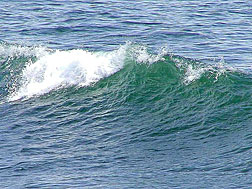- Number 371 |
- September 10, 2012
Seawater could be source of future uranium

Potential source of energy.
Fueling nuclear reactors with uranium harvested from the ocean could become more feasible because of a material developed by a team led by DOE's Oak Ridge National Laboratory.
The combination of ORNL's high-capacity reusable adsorbents and a Florida company's high-surface-area polyethylene fibers creates a material that can rapidly, selectively and economically extract valuable and precious dissolved metals from water. The material, HiCap, vastly outperforms today's best adsorbents, which perform surface retention of solid or gas molecules, atoms or ions. HiCap also effectively removes toxic metals from water, according to results verified by researchers at Pacific Northwest National Laboratory.
"We have shown that our adsorbents can extract five to seven times more uranium at uptake rates seven times faster than the world's best adsorbents," said Chris Janke, one of the inventors and a member of ORNL's Materials Science and Technology Division.
HiCap effectively narrows the fiscal gap between what exists today and what is needed to economically extract some of the ocean's estimated 4.5 billion tons of uranium. Although dissolved uranium exists in concentrations of just 3.2 parts per billion, the sheer volume means there would be enough to fuel the world's nuclear reactors for centuries.[Ron Walli, 865.576.0226,
wallira@ornl.gov]
